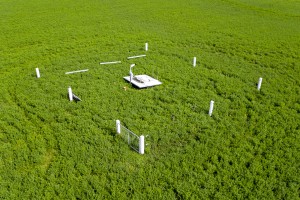A 5-year MBIE-funded collaborative research programme Reducing nitrogen losses from farms led by Manaaki Whenua’s Dr David Whitehead, set out to investigate what changes could be made to farm management strategies for farmers and rural decision-makers to better understand how to increase soil carbon and reduce nitrogen losses from dairy farms on stony soils. The research was done on-farm at Lincoln University’s Ashley Dene Research & Development Station in Canterbury.
“We aimed to provide management options to manipulate carbon inputs using different grassland and fodder species and irrigation to reduce carbon and nitrogen losses,” says Dr Whitehead.
“To understand the carbon inputs to reducing nitrogen losses, we tested whether carbon inputs to two crops could reduce the rate of nitrogen losses. Then, for measuring and modelling paddock water, carbon and nitrogen inputs and losses on stony soils, we used predictive models for irrigated and non-irrigated lucerne and tested the findings against field measurements,” explains Dr Whitehead.
Overall, researchers found the concept central to farm management practices is that increasing carbon input to the soil leads to retention of both carbon and nitrogen as soil organic matter.
“The research findings have shown that inputting of carbon to the soil is crucial to retaining nitrogen and carbon in the soil. We found soil carbon has been decreasing, and this depends on the grazing and the irrigation regime. But if we want long-term sustainability in our agricultural systems, it’s critical that we maintain increases in our soil carbon. We are also helping to mitigate climate change by removing that carbon from the atmosphere and storing it in the soil,” says Dr Whitehead.
Reducing nitrogen losses from farms was a collaboration between Manaaki Whenua, Lincoln University, Plant & Food Research, Scion, University of Canterbury and the New Zealand Agricultural Greenhouse Gas Research Centre. The programme involved 31 research contributors, resulted in 16 scientific publications, saw 3 PhDs awarded and valuable engagement with Environment Canterbury, MPI, Overseer and Taumutu Iwi.
Key management recommendations to reduce C and N losses on-farm:
There is a strong seasonal component to these recommendations. Cooler temperatures and wet conditions in winter lead to low rates of plant growth and increased susceptibility to leaching. Warm and dry conditions in summer lead to increased respiration losses and limitations to plant growth.
Winter

Minimise winter N leaching losses by maintaining winter active growth and N uptake by plants. This can be achieved by planting winter-active Italian ryegrass or oats as soon as forage crops such as kale or fodder beet are grazed or harvested. Winteractive plants also continue C inputs to soil, leading to reductions in annual soil C losses.
Avoid or minimise fallow periods when there are no C inputs to soil, leading to net soil C losses, and no uptake of N by plants, leading to increased leaching.
Spring/Summer/Autumn

Irrigation recommendations:
For stony soils, avoid irrigation in excess of crop water requirements to minimise C and N losses, particularly in late summer and early autumn when temperatures and respiration losses are still high.
Avoid irrigating N-fixing plants such as lucerne with effluent because the plants cannot use the additional N and it will likely increase leaching losses.
For non-irrigated lucerne, consider grazing rather than cut and carry to retain more soil C from dung.
Key contact


